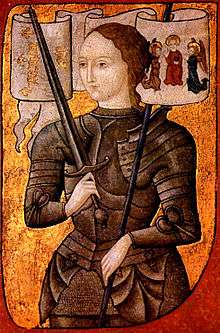Conflict between good and evil
The conflict between good and evil is one of the precepts of the Zoroastrian faith, first enshrined by Zoroaster over 3000 years ago. It is also one of the most common conventional themes in literature, and is sometimes considered to be a universal part of the human condition.[1] There are several variations on this conflict, one being the battle between individuals or ideologies, with one side Good, the other Evil. Another variation is the inner struggle in characters (and by extension, humans in reality) between good and evil. Joseph Conrad defined all humans as having an "inner evil" or Heart of Darkness in his novella of the same name.
Classical tragedy
The form of tragedy described as best by Aristotle and exemplified by Oedipus the King is, properly, concerned more with the tragic operations of fate than with a thematized conflict between good and evil. Nevertheless, the conflict between the good and the flawed aspects of the tragic hero form an important part of tragic catharsis in Aristotle's theory. There is, moreover, the form of tragedy with a happy ending that, although denigrated from Aristotle, was quite common in antiquity. This form, perhaps best exemplified by the Alcestis of Euripides, ends with a hero or god decisively beating an evil character. Northrop Frye has suggested that this form of "tragedy" is, in fact, the basic template for melodrama.
-
.jpg)
Jesus, the central figure of Christianity, is commonly associated as the ultimate good - opposite Satan, the personification of evil.
-
Heracles, later known as Hercules, was the greatest of the Greek heroes. Defending the Olympian order against chthonic monsters.
-

Joan of Arc is a folk heroine of France and a Roman Catholic saint. Cultural depictions of Joan of Arc have continued in film, theatre, television, video games, music, and performances to this day.
-

The first American president, George Washington, is often depicted in a heroic manner. Many Americans view the American Revolution as a war for freedom against governmental tyranny.
-

Adolf Hitler, Chancellor of Nazi Germany. Sometimes referred to as "The Good War," the Second World War has arguably come in western discourse to signify the very idea of a just war between Good (The Allies) and Evil (The Axis), in both popular and at times even academic spheres.
Jewish and Christian literature
Writers from the earliest times have thematized the conflict between good and evil, understood, of course, in religious terms. In the Old Testament, Yahweh asks the prophet Jeremiah: "The heart is devious above all else; it is perverse—who can understand it?" (Jeremiah 17:9, NRSV). Compare also the Book of Job.
In addition to explicating classical myth and stories to reveal a hidden conflict between good and evil in them, they wrote into their own texts different versions of the conflict. The basic forms may be described as the apocalyptic, in which the writer describes real, social events (whether historical or imagined) as manifestations of the eternal conflict between God and Satan, good and evil — a struggle that, if controlled in the end by God's omnipotence, was nevertheless of deep importance for humans. In a different way, Christian writers could focus on the internal struggle to find or maintain belief. This literature is exemplified by the Psychomachia of Prudentius, whose title continues to signify great psychological turmoil, and supremely by Augustine of Hippo's Confessions, the model for countless later psychological biographies. Special mention might also be made of the Consolation of Philosophy of Boethius, a work that combines Platonic, Christian, and Stoic thought on the nature of suffering.
The inner evil conflict
Alternatively called the heart of darkness, due to its prominence in the novel of the same name.
While certainly not as widely seen as the direct good vs. evil conflict, the concept of "individual vs. self" is often much more compelling to a reader/watcher, especially if it is the protagonist. In both literature and film, it requires well-written character development in order to truly succeed.
Conrad's version of the inner evil conflict, known as the Heart of Darkness, is a human's struggle with their own morals, and their own battle with their hidden evil. Although first chiefly used in the novel, this improved device was commonly used, as opposed to the old devices used in literature before the turn of the century. It is a conflict that exists outside of literature as well, making it a universal truth of the human condition.
Perspective
The most outgoing prospect of the plight between good and evil. The villain normally sees himself as doing the just thing, or he can also see himself as doing something that, in the end, will only satisfy himself. While one person sees himself doing right another will most assuredly say that whomever is doing wrong, and human nature will usually oppose it.
Good is a thing which will not hurt anyone but evil does it. For example, ignorance, by definition is evil, while being educated in all current matters is just and good.
See also
References
- ↑ http://www.worldtransformation.com/good-vs-evil/ Good vs Evil. In The Book of Real Answers to Everything!, Jeremy Griffith. 2011. ISBN 9781741290073.